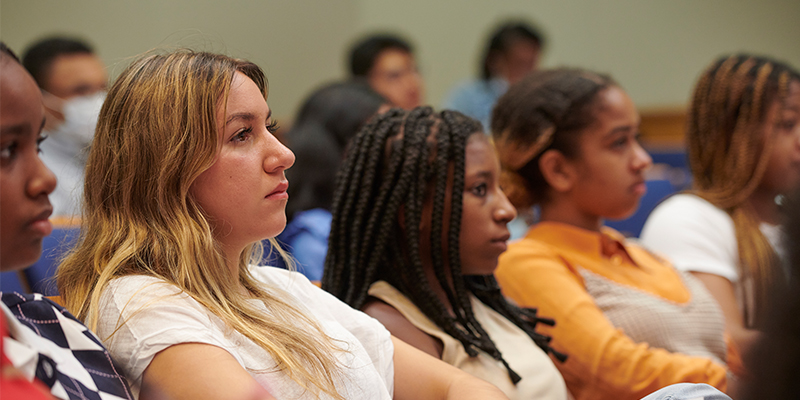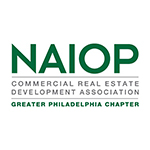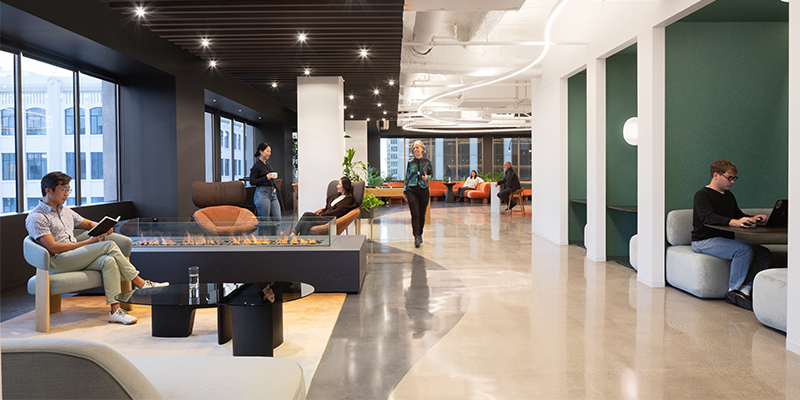Note: The NAIOP-Drexel Summer Program is a partnership between NAIOP Greater Philadelphia and Drexel University. The program, which just celebrated its fifth summer, brings together 30 high school rising juniors and seniors of color for a 10-day immersive experience, exposing them to nearly every aspect of commercial real estate. This five-part blog series seeks to deliver a little bit of that experience through the eyes of the students and their college-level ambassadors as well as the faculty and staff of both organizations who work year-round to plan and execute the program.
Chapter 2
Most kids look at summer vacation as, well, vacation. But Jeriel C., age 17, who attends Atlantic County Institute of Technology in New Jersey, is motivated. No one recommended the program to him; he found the NAIOP-Drexel Summer Program by doing his own research for real estate summer programs.
Standing outside of the lecture hall, quietly speaking with another student after a panel discussion on “The Greening of Commercial Real Estate,” he talked about his desire to “learn everything I can about real estate.” When encouraged to go back in and approach the moderator, Tony Ewing, for a business card, his face revealed a combination of nerves and excitement.
Excitement won. He approached Ewing, investment officer for EQT Exeter in Philadelphia and a NAIOP Greater Philadelphia board member, who had assembled the panel. As its moderator, he had deftly drawn the kids into asking questions with his energetic and welcoming demeanor. He put out his hand, smiled and spoke with Carter for some time.
“That’s what we want this program to do. The connections they make here are critical, especially because many of us teaching look like them, black and brown,” said Ewing, who is Black. “This is an opportunity for kids to see people working in the kinds of jobs they are interested in, and learn about jobs they don’t even know exist until they get here. It is encouraging when they see a reflection of their future selves.”
The panel featured four CRE professionals talking about various careers in or around sustainability and environmental stewardship. Kristen DeBias, president of Energetek, a minority and woman-owned commercial energy brokerage and commodity trading advisory operating in Pennsylvania, New Jersey and Ohio, made the difficult concept of renewable energy credits digestible for high school students, sharing that her company had a goal of being “net zero by 2050” and highlighting ways they were working to get there.
Students asked a lot of questions, from the micro of balance sheets to the macro of climate change goals. Architect Ian Smith, owner of IS-DG in Philadelphia, a minority-owned firm, responded to a question about the current condition of the world by saying, “Your futures are unpacking what we have given you, and you are helping us change how we think about” global warming and building design.
One student asked how developers balance the two in actual design, to which Lucas Hamilton, manager, applied building science at Saint-Gobain North America, offered a green roof as an example. “Green roofs are great for the environment but a heavy load, so you have to compensate in the design for that. They are also great for those who can see and touch it – it’s a called ‘biophilia,’” the innate human instinct to connect with nature and other human beings.”
Ewing added that from the spreadsheet side, “Green makes the [development] numbers go up which has to equate high value to higher rent,” touching on a math lesson from earlier in the morning. “It results in a higher ‘cap rate – you remember cap rate, right?” To which there was some head-bobbing and nervous giggling as students tried to connect the dots between the data.
When it was time to walk to the next session – their first property tour – they hit the street with a burst of energy, still high school students being let out for a field trip.
All photo credit to Ralph Oswald III.

Students attending a panel on “The Greening of Commercial Real Estate.” 
Kristen DeBias, president of Energetek makes a point about planning for sustainability while architect Ian Smith, founding principal of the firm IS-DG (right) and Lucas Hamilton, Manager, Applied Building Science at Saint-Gobain North America (left) looks on. 
As the panel looks on, Tony Ewing, Investment Officer for EQT Exeter in Philadelphia and a NAIOP Greater Philadelphia Board Member, moderates the panel and coaxes questions from the students. 
This roundtable discussion called “How Technology is Transforming the Development and Management of Commercial Real Estate: The Creation of Smart Buildings” captivated students. It featured Angela Camp of AION Management; Heather Schwemlein of Old Forge Builders and member, NAIOP Philadelphia Developing Leaders Program; and Zach Kravitz of IMC; and was moderated by Joe McLaughlin, an NAIOP Philadelphia Board Member, of Commonwealth Land Title Insurance Company. 
Jeriel C. and Aubrey C. enjoy a property tour.
Read the first chapter, Getting There, about the students’ arrival at Drexel University and how the summer program kicked off.
Read the third chapter, Hard Hats All Around, about the value of students participating in project tours and seeing CRE development in action.
Read the fourth chapter, Living the Learnings, about how the program provides real-world experience students can add to their resume.
Read the final chapter, A Race to the Finish, about the students’ experience competing in a case study competition.








